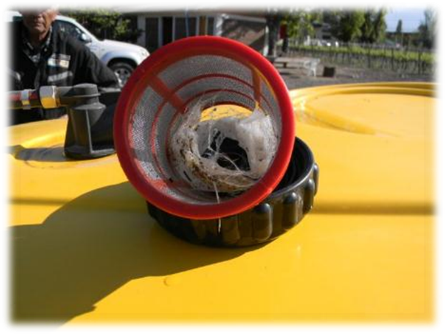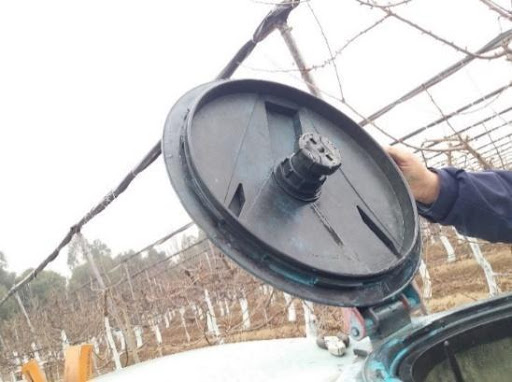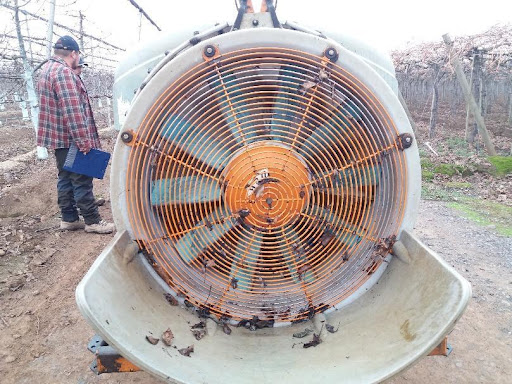By: Raúl Osorio, Agricultural Engineer, Director of Peulla Consulting and Services SPA – Carlos Tapia, Agricultural Engineer, M.Sc., Technical Director of Avium
The application of pesticides and foliar nutrition is one of the most important practices in fruit and vegetable production worldwide. In some cases, it represents more than 50% of the machinery used in an orchard in one season. Source: Jorge Riquelme S. and Patricio Abarca R. INIA Information Booklet No. 1.
It is a general consensus among leading cherry advisors and growers that “the next growing and production season of the crop begins in post-harvest.”
It is also an opportunity for a series of applications focused on maintaining the optimal physiological status of the crop in terms of nutrition, protection from diseases, use of specialized applications such as sunscreens and, on the other hand, applications for pests that are difficult to control such as phytophagous spider mites, San Jose scale and other pests present in the crop.
In each case, high efficacy must always be consistently achieved with the necessary amount of product and at a sustainable cost, attempting to generate minimal impact on the environment, applicators and consumers.
If we consider a summary (Table 1) of the development of foliar applications in the season, it can be detailed with different objectives, on different dates, always taking into account being within a parameter of application and control efficiency.
Table 1. Costs of a standard foliar program for cherry trees in production in central Chile. Cost of products and man-days (MWD) and machine-days (MWD), respectively. Source: Carlos Tapia, Raul Osorio.

It should be noted that this summary does not contemplate applications of specialty products such as fruit retention or setting programs, rain protection, color enhancers, etc. It does contemplate the use of dormancy breakers and homogenizers.
A much more comprehensive program, to the extent that it is technically justified, could generate an increase of around 40% of this cost, being able to have programs that exceed USD 3,500 / Ha only in
use of phytosanitary products and nutrition.
In view of this, it is essential to determine and verify the real need for such specific and expensive programs in each case. If this is the case (many orchards with high production potential warrant it), the most important thing is to be able to carry out these applications as efficiently as possible, from an operational and technical point of view.
Maintenance of agricultural spray equipment
It is at this point, therefore, that it is necessary to develop a rigorous inspection protocol for the machinery intended for the applications of each of these solutions and to carry out preventive maintenance on all available equipment (sprayers and tractors). Once the maintenance has been carried out, precise calibration guidelines must be available that are appropriate for each orchard situation according to topography, orchard age, driving system, among others.
In previous articles we have discussed the importance of each component of a spraying system and the annual preventive maintenance and periodicity of control, as well as the tractors used for this important task. On this occasion, a relative cost must be associated with the maintenance of each of them. Source: Newsletter of the University of Catalonia. Agricultural mechanization unit.

Hydraulic pump: Maintenance of this hydraulic component must be carried out once a season and its permanent inspection, considering the working condition of the pump, oil level and pressure of the device itself. During annual maintenance, membranes or sleeves and pistons must be replaced or repaired, depending on the model and hydraulic system. The cost of preventive maintenance of the hydraulic pump fluctuates between USD 350 - 400 per year.

Gimbal and gimbal sheath: Maintenance of this safety component must be carried out once a season and its inspection must be permanent, considering the condition of the cardan sheath and that it maintains its anti-rotation elements (holding chains). The lubrication of this mobile component must be carried out daily. The annual replacement of the cardan sheath and a cardan shaft is USD 200.

Command: The maintenance of this hydraulic component must be carried out once a season and its inspection must be permanent, considering the state of the pressure regulating valve, air outlet distributor, sector opening and the pressure gauge, which ideally has a reading scale of 1 in 1 isometric bar. The value of a control and a pressure gauge fluctuate between USD 200 - 220.


Filters: The cleaning maintenance of these components must be carried out permanently and in each application. There are: filling mouth filter, main or suction filter, nozzle filters and in-line filters. The value of the filling mouth filter set, suction filter and nozzle filter fluctuates between USD 70 and 75.



Pond and its components: The cleaning maintenance of this hydraulic component must be carried out permanently and after each application. Additionally, it is recommended to carry out the permanent maintenance and cleaning of the tank drain plug. One component of the tank is the level hoses that must be visible, translucent and with a level sight glass. Another component of the tank is the cover(s), which must be in perfect condition along with their pressure retaining valves; in addition, they must close easily. If it has a clean water tank, it must be in perfect condition with a cover and key to fulfill its function as a safety element. The value of a tank cover fluctuates between USD 35 and 40.


It is recommended to develop a pond cleaning schedule with neutral detergents and/or other specialized products. Cleaning should be done as frequently as possible, ideally every 5 times when we use products that are difficult to dissolve, and also products in mixtures. If possible due to cost and time, it should be done in each “round” of applications. The value of cleaning products fluctuates between USD 10 and 15 for each time the cleaning is done. If we add 21 applications per year, we have a cost of USD 210 – 305.

Pipes and hoses: The hoses must be checked for leaks or punctures and it is therefore always recommended to keep them routed through the chassis of the equipment. The cleaning maintenance of these hydraulic components must be carried out permanently and after each application. It is recommended to develop a cleaning schedule with detergents and specific cleaning products at least 3 times a season and ideally 5 times when we use products that are difficult to dissolve and also products in mixtures. The cost of changing the hoses fluctuates between USD 60-70.

Air group: The maintenance of this component must be carried out once a season, verifying the proper functioning of the gearbox in its high, low and neutral positions. The good condition of the blades and their angle adjustment of the fan assembly must be verified. The protective grid of the air assembly must be permanently verified, since it is a very important safety element for the applicators. If the equipment has deflectors in the air assembly, their good maintenance condition and position must be permanently verified. The value of preventive maintenance of the air assembly (oil for gearbox, lubrication, possible repairs to the protective grid) fluctuates between USD 65 - 70.


Nozzles: The maintenance of these components consists of permanently checking their cleanliness, ideally before each “round” of applications. To verify the proper functioning of the nozzles, the flow rate they deliver per minute must be checked and it must be verified that it is the one indicated by the manufacturer at a certain pressure (tests at 10 bar are recommended). If the flow rate detected is greater than 10 % of that indicated by the manufacturer at 10 bar, the nozzles with this defect must be replaced. The value of an annual nozzle change, assuming a total of 16 nozzles, fluctuates between USD 70 and 80.

Stirring system: The proper functioning of this hydraulic component must be checked continuously before each “round” of application. The maintenance cost of the agitation system can fluctuate between USD 30 – 40.
Diagnostic, calibration and certification service for agricultural spraying equipment
There are countless professionals dedicated to providing calibration services for agricultural sprayers and equipment that diagnose the components of sprayers to carry out repairs, improvements, cleaning and annual or periodic maintenance. The purpose of each of them is to have equipment that meets the applications necessary for crops with the greatest accuracy. In this way, it is possible to achieve effective and efficient results as a result of the use of different solutions applied to orchards.
The prices of the services available for this purpose vary between USD 200–250.
In summary, the cost associated with permanent preventive maintenance of the atomizing equipment and a good diagnostic and calibration service are presented in Table 2:
Table 2. Maintenance costs of atomizing equipment in USD dollar/equipment. Source: Carlos Tapia, Raul Osorio.

Finally, it is possible to point out that a spraying equipment, with its respective tractor, efficiently assists a range of 25 to 30 ha; therefore, the cost per ha of maintenance item/ha fluctuates between USD/ha 53 - 63. This cost only represents 1.7% of the costs of an annual program in cherry trees.
Conclusions: In order to develop effective and efficient application management plans, it is necessary to have equipment previously diagnosed in all its components, repaired and replaced its critical elements, perform annual and periodic maintenance, permanent cleaning and have highly trained personnel to develop the applications that will translate into the success of crops at harvest, with the least impact on the environment and people.








